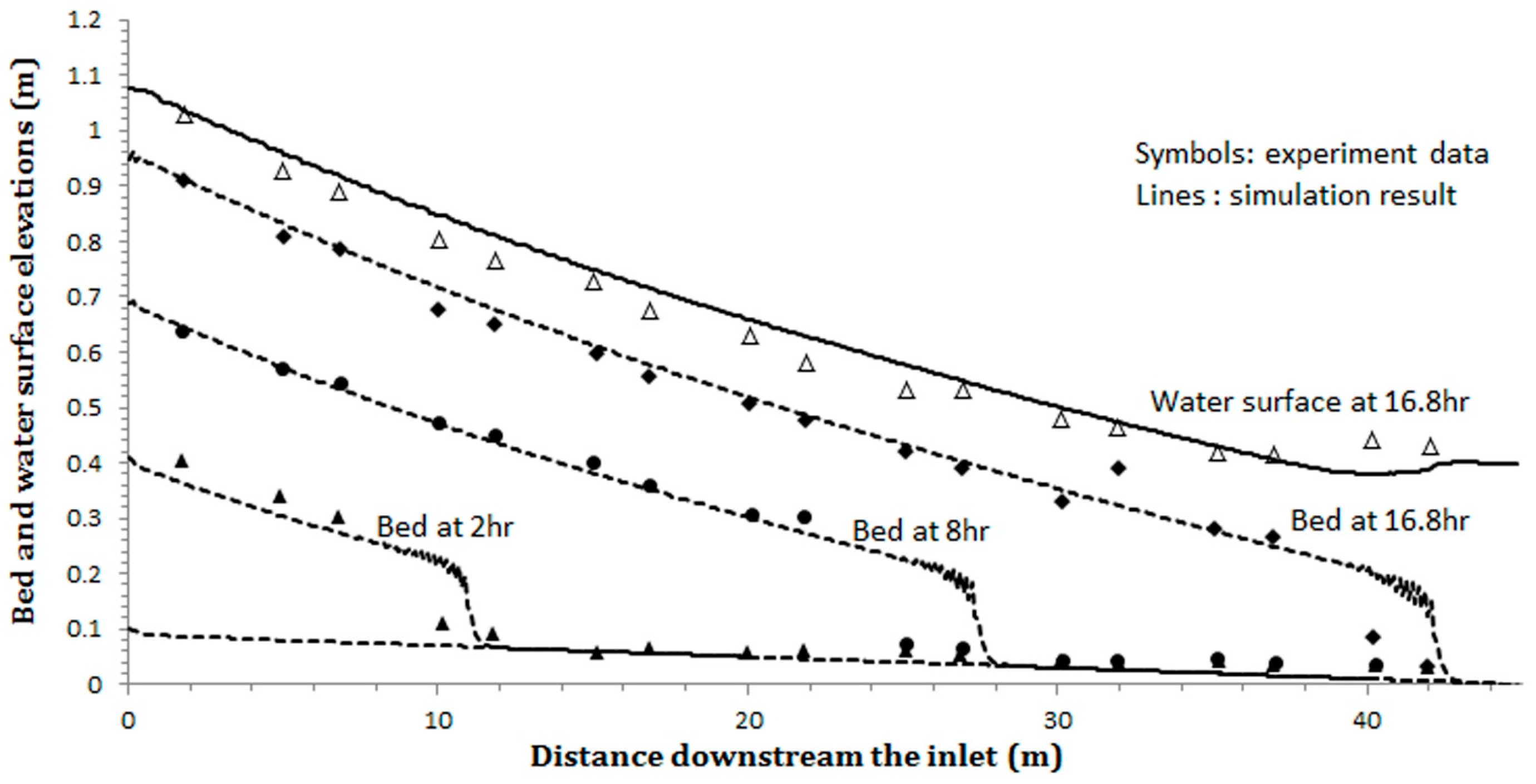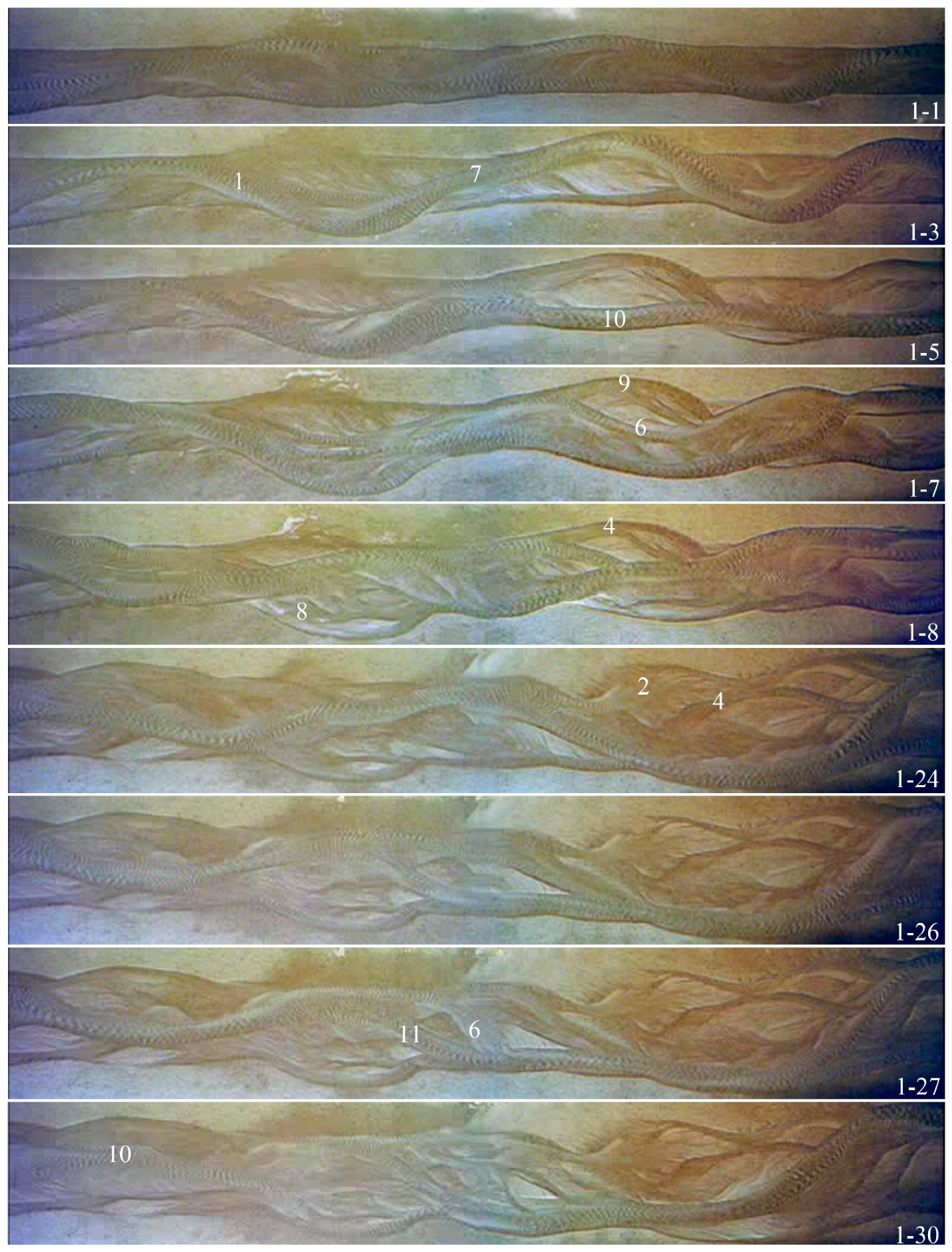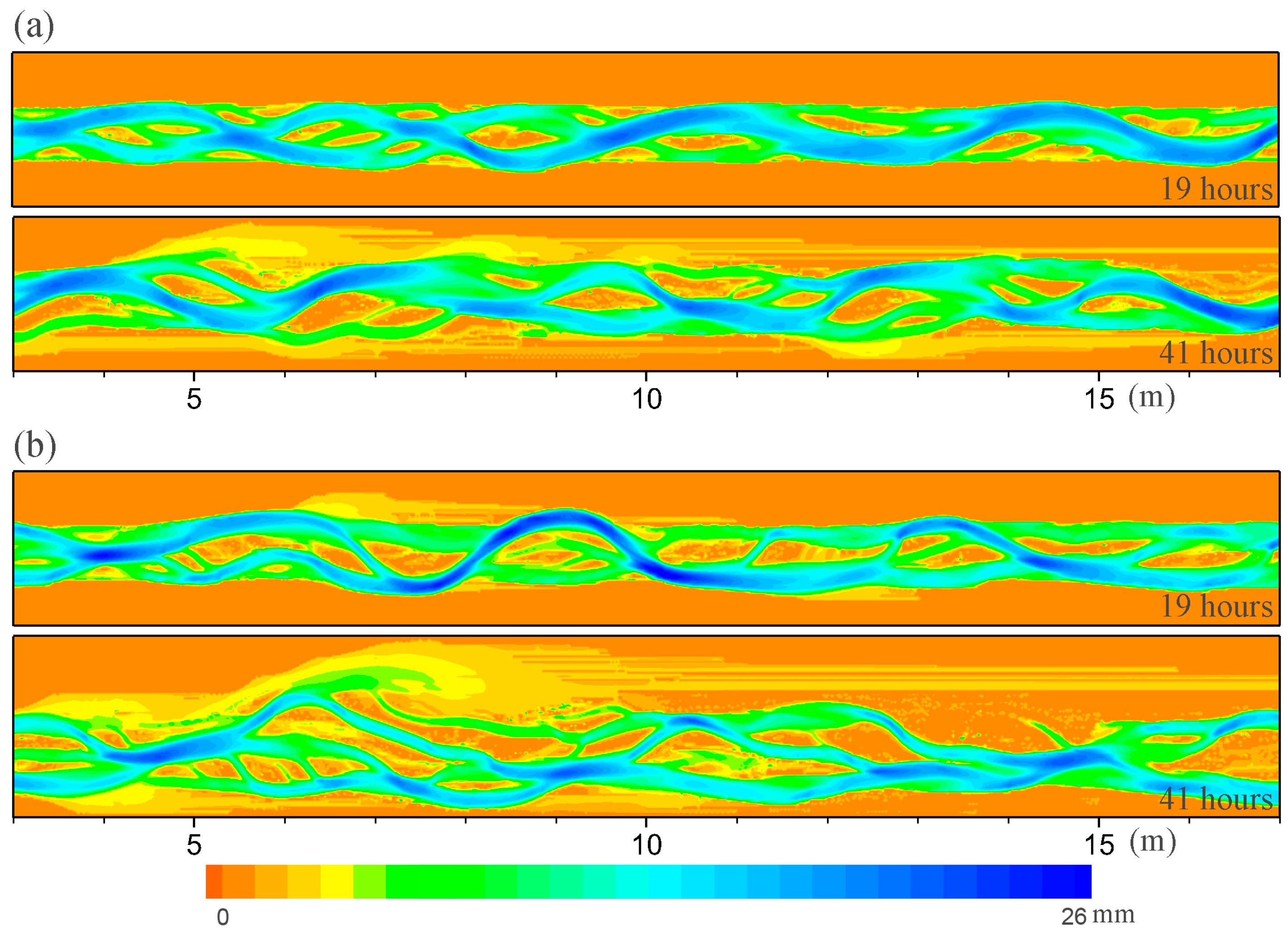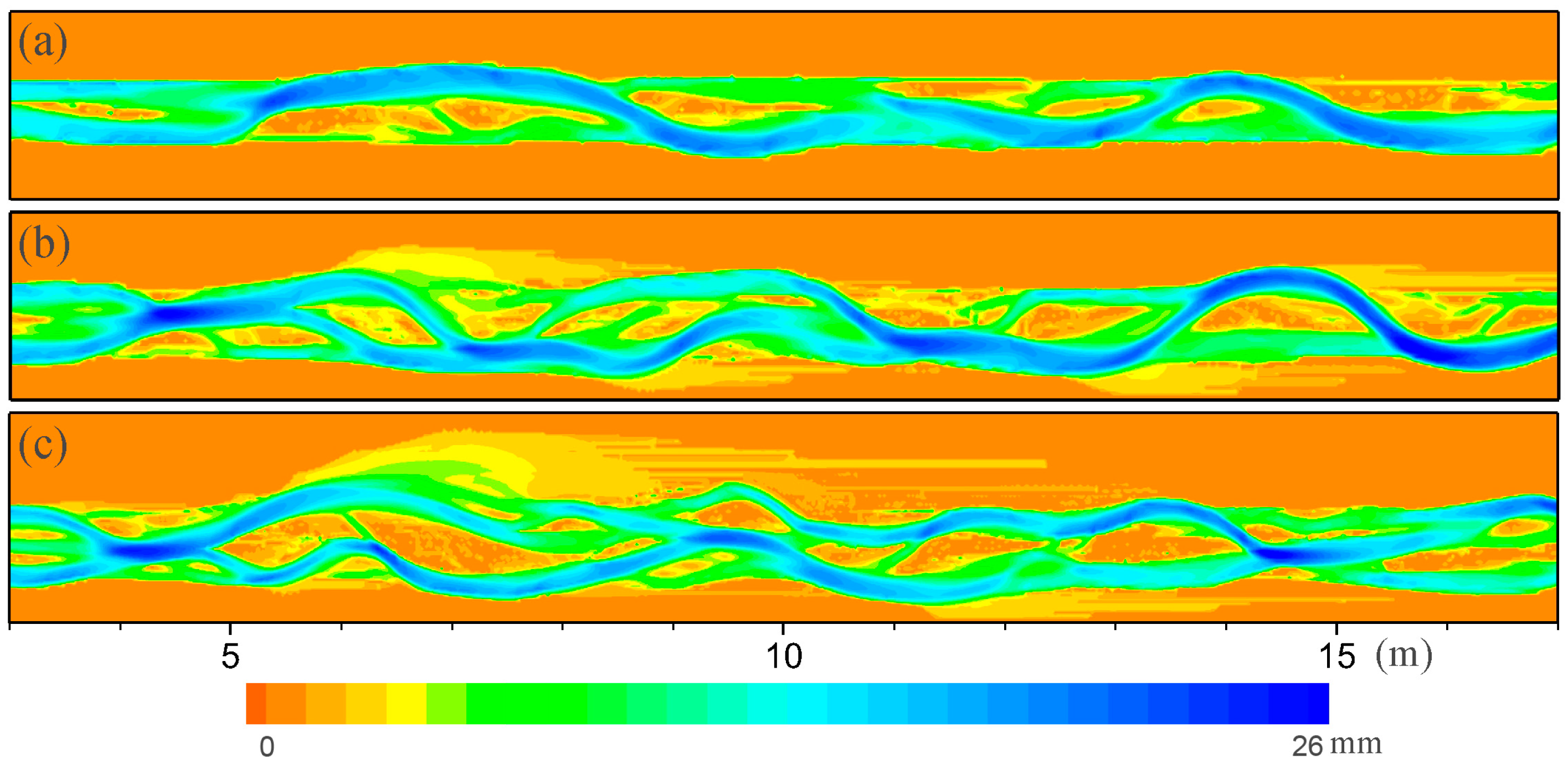Simulating Laboratory Braided Rivers with Bed-Load Sediment Transport
Abstract
:1. Introduction
2. Numerical Model and Test
2.1. Numerical Model
2.1.1. Governing Equations for Flow and Sediment Transport
2.1.2. Influence of Bed Slope and Secondary Flow
2.1.3. Areal Fraction and Sheltering Effect for Non-uniform Sediments
2.1.4. Bed Deformation and Multiple Bed Layers
2.2. Model Morphodynamic Test
3. Braided River Simulation
3.1. Model Setup
3.2. Morphodynamic Properties
3.2.1. River Evolution Processes and Phenomena
3.2.2. Properties of a Typical Braided River
3.2.3. Sensitivity Analysis
3.3. Statistical Characteristics
3.3.1. Braiding Intensity
3.3.2. State Space Plots
3.3.3. Transect Topography and Slope Frequency
4. Discussion and Conclusions
Acknowledgments
Author Contributions
Conflicts of Interest
References
- Bertoldi, W.; Gurnell, A.; Surian, N.; Tockner, K.; Zanoni, L.; Ziliani, L.; Zolezzi, G. Understanding reference processes: Linkages between river flows, sediment dynamics and vegetated landforms along the Tagliamento River, Italy. River Res. Appl. 2009, 25, 501–516. [Google Scholar] [CrossRef]
- Knighton, D.A. Fluvial Forms and Processes: A New Perspective; Arnold, Hodder Headline, PLC: London, UK, 1998; p. 383. [Google Scholar]
- Ham, D.G.; Church, M. Bed-material transport estimated from channel morphodynamics: Chilliwack River, British Columbia. Earth Surf. Process. Landf. 2000, 25, 1123–1142. [Google Scholar] [CrossRef]
- Smith, N.D.; Smith, D.G. William River: An outstanding example of channel widening and braiding caused by bed-load addition. Geology 1984, 12, 78. [Google Scholar] [CrossRef]
- Brierley, G.J.; Hickin, E.J. Channel planform as a non-controlling factor in fluvial sedimentology: The case of the Squamish River floodplain, British Columbia. Sediment. Geol. 1991, 75, 67–83. [Google Scholar] [CrossRef]
- Huang, H.Q.; Chang, H.H.; Nanson, G.C. Minimum energy as the general form of critical flow and maximum flow efficiency and for explaining variations in river channel pattern. Water Resour. Res. 2004, 40, W04502. [Google Scholar] [CrossRef]
- Bridge, J.S. The interaction between channel geometry, water flow, sediment transport and deposition in braided rivers. In Braided Rivers; Best, J.L., Bristow, C.S., Eds.; Geological Society: London, UK, 1993; pp. 13–71. [Google Scholar]
- Cui, Y.; Paola, C.; Parker, G. Numerical simulation of aggradation and downstream fining. J. Hydraul. Res. 1996, 34, 185–204. [Google Scholar] [CrossRef]
- Duc, B.M.; Wenka, T.; Rodi, W. Numerical modeling of bed deformation in laboratory channels. J. Hydraul. Eng. 2004, 130, 894–904. [Google Scholar] [CrossRef]
- Meselhe, E.A.; Georgiou, I.; Allison, M.A.; McCorquodale, J.A. Numerical modeling of hydrodynamics and sediment transport in lower Mississippi at a proposed delta building diversion. J. Hydrol. 2012, 472, 340–354. [Google Scholar] [CrossRef]
- Bai, Y.; Duan, J.G. Simulating unsteady flow and sediment transport in vegetated channel network. J. Hydrol. 2014, 515, 90–102. [Google Scholar] [CrossRef]
- Murray, A.B.; Paola, C. A cellular model of braided rivers. Nature 1994, 371, 54–57. [Google Scholar] [CrossRef]
- Coulthard, T.J.; Hicks, D.M.; Van De Wiel, M.J. Cellular modelling of river catchments and reaches: Advantages, limitations and prospects. Geomorphology 2007, 90, 192–207. [Google Scholar] [CrossRef]
- Schuurman, F.; Marra, W.A.; Kleinhans, M.G. Physics-based modeling of large braided sand-bed rivers: Bar pattern formation, dynamics, and sensitivity. J. Geophys. Res. 2013, 118, 2509–2527. [Google Scholar] [CrossRef]
- Slingerland, R.; Smith, N.D. River avulsions and their deposits. Annu. Rev. Earth Planet. Sci. 2004, 32, 257–285. [Google Scholar] [CrossRef]
- Jang, C.L.; Shimizu, Y. Numerical simulations of the behavior of alternate bars with different bank strengths. J. Hydraul. Res. 2005, 43, 596–612. [Google Scholar] [CrossRef]
- Jang, C.L.; Shimizu, Y. Numerical simulation of relatively wide, shallow channels with erodible banks. J. Hydraul. Eng. 2005, 131, 565–575. [Google Scholar] [CrossRef]
- Nicholas, A.P. Modelling the continuum of river channel patterns. Earth Surf. Process. Landf. 2013, 38, 1187–1196. [Google Scholar] [CrossRef]
- Schuurman, F.; Kleinhans, M.G. Bar dynamics and bifurcation evolution in a modelled braided sand-bed river. Earth Surf. Process. Landf. 2015, 40, 1318–1333. [Google Scholar] [CrossRef]
- Yang, H. Development of a Physics-Based Morphodynamic Model and Its Application to Braided Rivers. Ph.D. Thesis, Cardiff University, Cardiff, UK, 2013. [Google Scholar]
- Yang, H.; Lin, B.; Zhou, J. Physics-based numerical modelling of large braided rivers dominated by suspended sediment. Hydrol. Process. 2015, 29, 1925–1941. [Google Scholar] [CrossRef]
- Kleinhans, M.G. Sorting out river channel patterns. Prog. Phys. Geogr. 2010, 34, 287–326. [Google Scholar] [CrossRef]
- Takebayashi, H.; Okabe, T. Numerical modelling of braided streams in unsteady flow. Proc. ICE Water Manag. 2009, 162, 189–198. [Google Scholar] [CrossRef]
- Lotsari, E.; Wainwright, D.; Corner, G.D.; Alho, P.; Kayhko, J. Surveyed and modelled one-year morphodynamics in the braided lower Tana River. Hydrol. Process. 2014, 28, 2685–2716. [Google Scholar] [CrossRef]
- Schuurman, F.; Kleinhans, M.G. Self-Formed Braid Bars in a Numerical Model; American Geophysical Union Fall Meeting Abstracts: Washington, DC, USA, 2011; p. 672. [Google Scholar]
- Ikeda, S.; Parker, G.; Sawai, K. Bend theory of river meanders, part 1: Linear development. J. Fluid Mech. 1981, 112, 363–377. [Google Scholar] [CrossRef]
- Parker, G.; Sawai, K.; Ikeda, S. Bend theory of river meanders, part 2: Nonlinear deformation of Finite-amplitude bends. J. Fluid Mech. 1982, 115, 303–314. [Google Scholar] [CrossRef]
- Kleinhans, M.G.; van den Berg, J.H. River channel and bar patterns explained and predicted by an empirical and a physics-based method. Earth Surf. Process. Landf. 2011, 36, 721–738. [Google Scholar] [CrossRef]
- Wu, W. Computational River Dynamics; Taylor & Francis Group: London, UK, 2007; p. 499. [Google Scholar]
- Ferguson, R.I.; Ashmore, P.E.; Ashworth, P.J.; Paola, C.; Prestegaard, K.L. Measurements in a braided river chute and lobe: 1. Flow pattern, sediment transport, and channel change. Water Resour. Res. 1992, 28, 1877–1886. [Google Scholar] [CrossRef]
- Egozi, R.; Ashmore, P.E. Experimental analysis of braided channel pattern response to increased discharge. J. Geophys. Res. 2009, 114. [Google Scholar] [CrossRef]
- Leduc, P.; Ashmore, P.; Gardner, J.T. Grain sorting in the morphological active layer of a braided river physical model. Earth Surf. Dyn. 2015, 3, 577. [Google Scholar]
- Van Niekerk, A.; Vogel, K.R.; Slingerland, R.L.; Bridge, J.S. Routing of heterogeneous sediments over movable bed: Model development. J. Hydraul. Eng. 1992, 118, 246–262. [Google Scholar] [CrossRef]
- Van Rijn, L.C. Sediment transport, part III: Bed forms and alluvial roughness. J. Hydraul. Eng. 1984, 110, 1733–1754. [Google Scholar] [CrossRef]
- Liang, D.; Falconer, R.A.; Lin, B. Comparison between TVD-MacCormack and ADI-type solvers of the shallow water equations. Adv. Water Resour. 2006, 29, 1833–1845. [Google Scholar] [CrossRef]
- Liang, D.; Lin, B.; Falconer, R.A. Simulation of rapidly varying flow using an efficient TVD-MacCormack scheme. Int. J. Numer. Methods Fluids 2007, 53, 811–826. [Google Scholar] [CrossRef]
- Van Rijn, L.C. Sediment transport, part I: Bed load transport. J. Hydraul. Eng. 1984, 110, 1431–1456. [Google Scholar] [CrossRef]
- Van Rijn, L.C. Principles of Sediment Transport in Rivers, Estuaries and Coastal Seas; Aqua Publications: Amsterdam, The Netherlands, 1993. [Google Scholar]
- Engelund, F. Flow and bed topography in channel bends. J. Hydraul. Div 1974, 100, 1631–1648. [Google Scholar]
- Karim, F. Bed material discharge prediction for nonuniform bed sediments. J. Hydraul. Eng. 1998, 124, 597–604. [Google Scholar] [CrossRef]
- Van Rijn, L.C. Unified view of sediment transport by currents and waves III: Graded beds. J. Hydraul. Eng. 2007, 133, 761–775. [Google Scholar] [CrossRef]
- Wei, Z.L. One Dimensional Sediment Model for the Yellow River; Report of Wuhan University of Hydro-electrical Power (In Chinese). Wuhan University: Wuhan, China, 1993. [Google Scholar]
- Zhou, J.; Lin, B. Modelling Bed Evolution Processes in Alluvial Rivers. In Proceedings of the International Conference on Fluvial Hydraulics, Izmir, Turkey, 3–5 September 2008; pp. 1305–1311. [Google Scholar]
- Lin, B.; Falconer, R.A. Tidal flow and transport modeling using Ultimate Quickest scheme. J. Hydraul. Eng. 1997, 123, 303–314. [Google Scholar] [CrossRef]
- Sun, J.; Lin, B.; Yang, H. Development and application of a braided river model with non-uniform sediment transport. Adv. Water Resour. 2015, 81, 62–74. [Google Scholar] [CrossRef]
- Seal, R.; Paola, C.; Parker, G.; Southard, J.B.; Wilcock, P.R. Experiments on downstream fining of gravel: I. Narrow-channel runs. J. Hydraul. Eng. 1997, 123, 874–884. [Google Scholar] [CrossRef]
- Paola, C.; Parker, G.; Seal, R.; Sinha, S.K.; Southard, J.B.; Wilcock, P.R. Downstream fining by selective deposition in a laboratory flume. Science 1992, 258, 1757–1760. [Google Scholar] [CrossRef] [PubMed]
- Ashmore, P.E. Channel morphology and bed load pulses in braided, gravel-bed streams. Geogr. Ann. Ser. A 1991, 73, 37–52. [Google Scholar] [CrossRef]
- Hoey, T.; Sutherland, A.J. Channel morphology and bedload pulses in braided rivers: A laboratory study. Earth Surf. Process. Landf. 1991, 16, 447–462. [Google Scholar] [CrossRef]
- Shvidchenko, A.B.; Kopaliani, Z.D. Hydraulic modeling bed load transport in gravel bed Laba River. J. Hydraul. Eng. 1998, 124, 778–785. [Google Scholar] [CrossRef]
- Warburton, J.; Davies, T.R.H. Use of hydraulic models in management of braided gravel-bed rivers. In Gravel-Bed Rivers in the Environment; Klingeman, P.C., Beschta, R.L., Komar, P.D., Bradley, J.B., Eds.; Water Resources Publications: Littleton, CO, USA, 1998; pp. 512–542. [Google Scholar]
- Egozi, R.; Ashmore, P.E. Defining and measuring braiding intensity. Earth Surf. Process. Landf. 2008, 33, 2121–2138. [Google Scholar] [CrossRef]
- Ashmore, P.E. Anabranch confluence kinetics and sedimentation processes in gravel-braided streams. In Braided Rivers; Best, J.L., Bristow, C.S., Eds.; Geological Society, Special Publications: London, UK, 1993; Volume 75, pp. 129–146. [Google Scholar]
- Ashmore, P.; Bertoldi, W.; Tobias Gardner, J. Active width of gravel-bed braided rivers. Earth Surf. Process. Landf. 2011, 36, 1510–1521. [Google Scholar] [CrossRef]
- Doeschl, A.B.; Ashmore, P.E.; Davison, M. Methods for Assessing Exploratory Computational Models of Braided Rivers. In Braided Rivers: Process, Deposits, Ecology and Management; Sambrook-Smith, G.H., Best, J.L., Bristow, C.S., Petts, G.E., Jarvis, I., Eds.; Wiley-Blackwell: Malden, MA, USA, 2006; pp. 177–197. [Google Scholar]
- Murray, A.B.; Paola, C. A new quantitative test of geomorphic models, applied to a model of braided streams. Water Resour. Res. 1996, 32, 2579–2587. [Google Scholar] [CrossRef]
- Ashmore, P.E. How do gravel-bed rivers braid? Can. J. Earth Sci. 1991, 28, 326–341. [Google Scholar] [CrossRef]
- Bertoldi, W.; Zanoni, L.; Tubino, M. Planform dynamics of braided streams. Earth Surf. Process. Landf. 2009, 34, 547–557. [Google Scholar] [CrossRef]
- Sapozhnikov, V.B.; Murray, A.B.; Paola, C.; Foufoula-Georgiou, E. Validation of Braided-Stream Models: Spatial state-space plots, self-affine scaling, and island shapes. Water Resour. Res. 1998, 34, 2353–2364. [Google Scholar] [CrossRef]
- Rosatti, G. Validation of the physical modeling approach for braided rivers. Water Resour. Res. 2002, 38, 1295. [Google Scholar] [CrossRef]












| Sand Groups | 1 | 2 | 3 | 4 | 5 | 6 | 7 | 8 | 9 | |||||||||
|---|---|---|---|---|---|---|---|---|---|---|---|---|---|---|---|---|---|---|
| Grain Size (mm) | 0.25 | 0.5 | 0.7 | 1.0 | 1.5 | 2.0 | 3.0 | 4.0 | 6.0 | 8.0 | ||||||||
| Percentage (%) | 4.95 | 14.05 | 9.20 | 16.16 | 13.64 | 12.00 | 11.78 | 11.22 | 4.42 | 2.58 | ||||||||
| Finer than (%) | 4.95 | 19.00 | 28.20 | 44.36 | 58.00 | 70.00 | 81.78 | 93.00 | 97.42 | 100.0 | ||||||||
| Parameters | Predicted River | Experimental River | ||||
|---|---|---|---|---|---|---|
| BIA | BIT | BIA/BIT | BIA | BIT | BIA/BIT | |
| Exp. 7 | 1.1 | 2.6 | 0.35–0.5 | 1.1 | 2.8 | 0.3–0.5 |
| Exp. 8 | 1.8 | 4.5 | 0.35–0.5 | 1.3 | 3.8 | 0.3–0.5 |
© 2017 by the authors. Licensee MDPI, Basel, Switzerland. This article is an open access article distributed under the terms and conditions of the Creative Commons Attribution (CC BY) license (http://creativecommons.org/licenses/by/4.0/).
Share and Cite
Yang, H.; Lin, B.; Sun, J.; Huang, G. Simulating Laboratory Braided Rivers with Bed-Load Sediment Transport. Water 2017, 9, 686. https://doi.org/10.3390/w9090686
Yang H, Lin B, Sun J, Huang G. Simulating Laboratory Braided Rivers with Bed-Load Sediment Transport. Water. 2017; 9(9):686. https://doi.org/10.3390/w9090686
Chicago/Turabian StyleYang, Haiyan, Binliang Lin, Jian Sun, and Guoxian Huang. 2017. "Simulating Laboratory Braided Rivers with Bed-Load Sediment Transport" Water 9, no. 9: 686. https://doi.org/10.3390/w9090686




